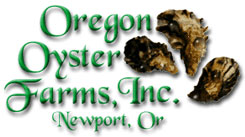 |
 |
|
|
History of the Oyster Industry on the Yaquina Bay,
and how Oregon Oyster Farms got it's start The Yaquina Bay oyster industry began with a shipwreck. In January, 1852, the schooner "Juliet" was forced ashore by storms, and her captain and crew were stranded in this area for two months. When they reached the Willamette Valley, the captain reported that the Yaquina River was abundant with oysters, clams and fish of all kinds. Other visitors also reported on the abundance of oysters, and in 1863, two commercial oyster firms appeared on Yaquina Bay. The first was Winant & Company, represented by James Winant and Solomon Dodge, who established a community known as Oysterville. The second was Ludlow & Company, represented by Richard Hillyer. At that time, Yaquina Bay was a part of the Grand Ronde reservation, and disputes quickly arose as to who could do what, and at what cost. The Indian agent, one Ben Simpson, demanded a fee of 15 cents for each bushel harvested be paid to the tribes. Winant & Company complied; Ludlow & Company did not. Instead, they filed a lawsuit, which they lost, and then left the area. In 1865, a Dr. Kellog from Portland entered the scene. He established a settlement called Pioneer about the site of today's Elk City, and built a warehouse. While he was away, soldiers tore it down. He appealed to the Superintendent of Indian Affairs in Salem, but received hostility instead of help. Being more determined than Ludlow & Company, Kellogg carried his fight to Washington, which found that the agency had exceeded its authority, and ordered an end to the harassment of the doctor. The battle for the bay caught the attention of other potential settlers, and they began to push for the opening of the area. In 1866, the Department of the Interior removed from the Grand Ronde reservation the area from the Alsea River to Cape Foulweather and settlement began. The oyster business flourished for a few years, until the stock of native oysters was nearly depleted. Attempts to grow eastern oysters in Yaquina Bay failed, and by 1900 only a handful of men were involved in oystering in the bay, and that on a very small scale. In 1907, the Wachsmuth family opened what is today Dan and Louie's Oyster Bar in Portland. After that they founded today's Oregon Oyster Farms to assure a supply of high quality oysters. In 1918, the Pacific oyster from Japan was introduced into the bay. While the Pacifics grew well here, they could not reproduce in the colder water, so each year growers would import seed from Japan. World War II brought an end to the importation of seed, and even though it was resumed after the war, it became increasingly expensive. Oyster growers began to look for a better way. In 1968, Professor Willy Breese and Dr. Anja Robinson, along with Newport's Tom Becker and Mo Niemi, built three insulated rooms at the Marine Science Center, began research into the feasibility of hatching Pacific oysters locally. From those three rooms and Breese and Robinson's research, combined with the research of others, gave us the oyster industry in Yaquina Bay as we know it today. The west coast has now surpassed the east and gulf coasts as the top producer of oysters. |
|
Home | History | Retail Store | Products | Recipes | Photo Gallery  |